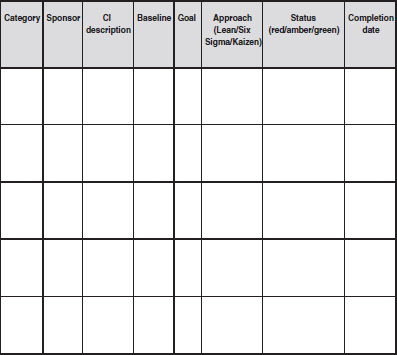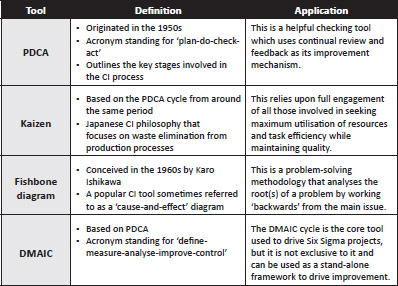Activity 31
Continuous improvement and review
Overview
Continuous improvement (CI) is a philosophy that aims to ensure ongoing effort in relation to product/process enhancement. It can be termed as either ‘incremental’ or ‘breakthrough’ depending upon the scale of improvement and is directly applicable to the output solutions from a category management process, such as projects, contracts, supplier relationships and strategies.
There are many authors who have written on the subject of CI, the most notable being W. Edwards Deming, who popularised the plan-do-check-act (PDCA) cycle (a.k.a. ‘Deming wheel’) in the 1950s, upon which many other CI tools and techniques are founded.
Organisations undertaking CI can do so formally or informally. It occurs formally where production follows a ‘lean’ approach (or similar) and therefore naturally arises as part of an organisation’s standard operating procedures, whereas informal CI may evolve or be included as part of a project framework.
Elements
CI activity takes place after the implementation stage of the category management process. However, it should be noted that the baseline/starting point from which CI commences will need to be mapped out as soon as practicably possible, as any gains should be measured and substantiated.
Outlined in Figure 5.10 are the most popular CI tools and techniques. They may be used in isolation or in conjunction with each other.
So what?
CI is an important part of category management as it facilitates double-loop learning that can create additional value for key stakeholders while providing developmental opportunities for team members. It also instils a culture of quality through continual monitoring and review activities.
CI should be regarded as a ‘business-as-usual’ activity, and therefore may be ‘offloaded’ onto those operating in the business to manage towards the latter stages of the project. However, it can be beneficial to take control of this activity as it can realise some significant benefits which may not have been previously considered in the initial phases of the category management process.
To avoid CI being overlooked and lost amongst the tyranny of ‘urgent’, business-as-usual activities, those organisations who adopt a more mature category management process will instil a wave-generation approach to scheduling category reviews in order to realise further additional value.
Category management application
- Provides a mechanism for continual monitoring and review
- Enables the capture and application of customer feedback
- Allows for learnings to be shared, which therefore may improve overall capability within the function
- Allows for second-, third- and fourth-generation benefits to be yielded
- Supports the benefits-realisation process
Limitations
While continually striving to improve is undoubtedly best practice, the array of CI methods and concepts available for use can be confusing. It is a very broad subject with many different schools of thought, and comprehending the multitude of offerings can be off-putting to the category manager who is simultaneously attempting to manage many facets of a category project.
It should be remembered that the focus of CI for category managers is the review and overall improvement of the output solution from the category management process (rather than improving the category process itself). There is no ‘one-size-fits-all’ solution and so the approach will need to be customised for each category.
It should also be noted that implementing CI requires time and effort, and sometimes resources have already been pulled from the category project as it nears the closing stages, leaving to complete the last actions only a few individuals, who may need to prioritise and therefore forego CI accordingly.
Template
The following template may be used to assist with the CI process:
- Template 31: Continuous improvement checklist


